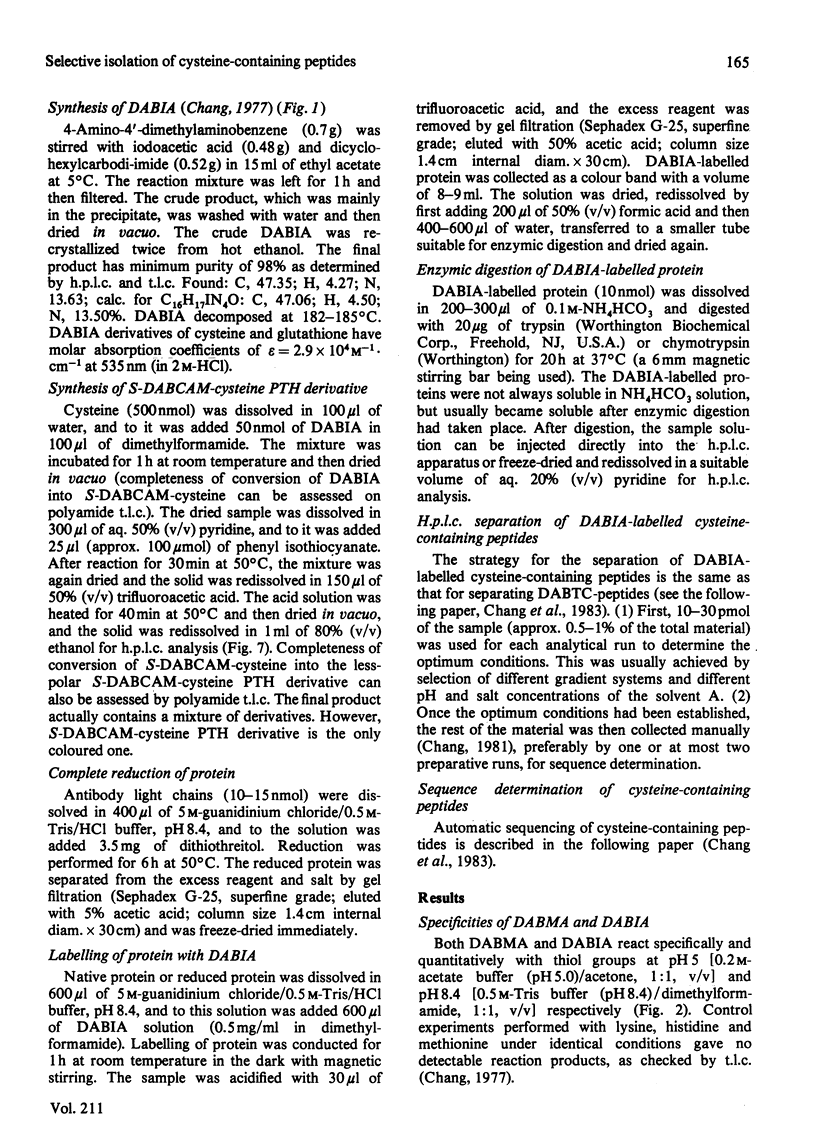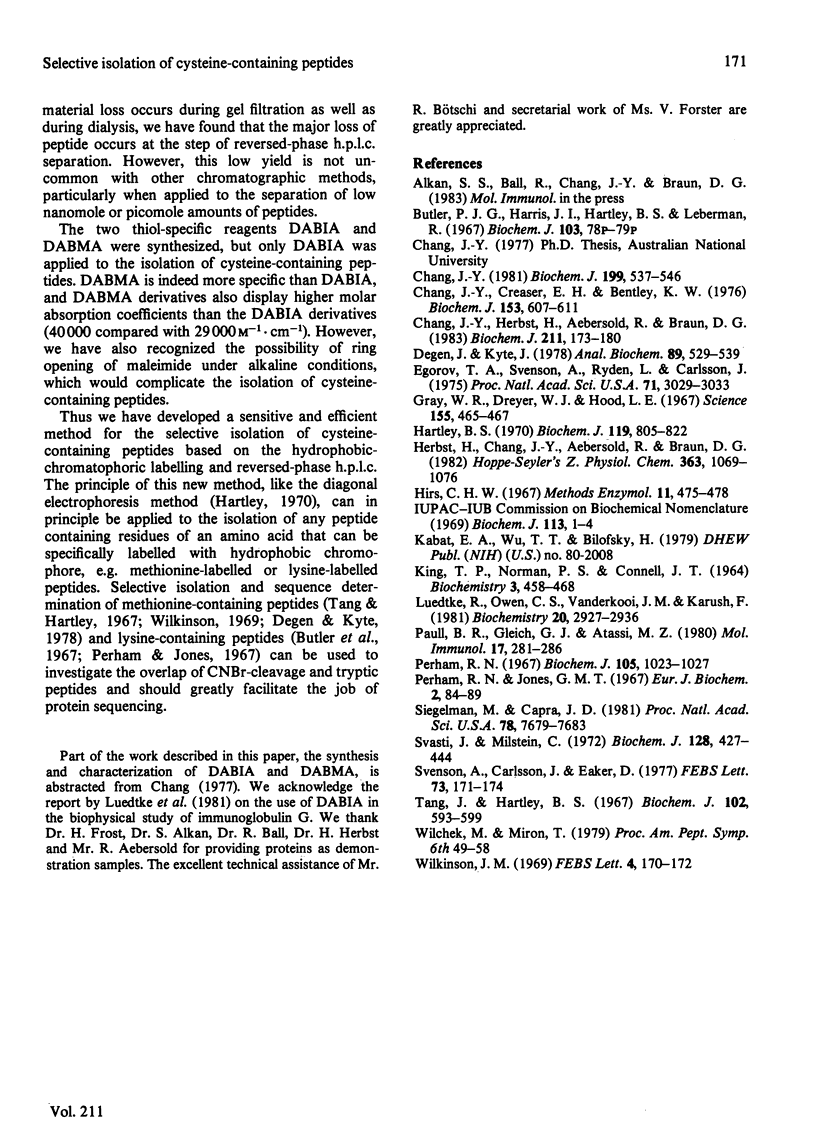Abstract
A new method for the selective isolation of cysteine-containing peptides was designed. The method is based on the specific labelling of thiol groups with a hydrophobic chromophore followed by enzymic fragmentation of the labelled protein and reversed-phase high-pressure liquid-chromatographic separation of the peptide mixture. This new method has several distinct advantages: (1) the hydrophobic-chromophore-labelled cysteine-containing peptides are easily separated from non-cysteine-containing peptides by reversed-phase high-pressure liquid chromatography; (2) only cysteine-containing peptides are detected in the visible region with sensitivity at the low picomole level; this high sensitivity allows isolation of nanogram amounts of pure cysteine-containing peptide; (3) during sequence determination of the chromophore-labelled cysteine-containing peptides, the cysteine residues are released as coloured anilinothiazolinone derivatives and can be detected directly in the picomole range; (4) with proteins bearing several disulphide groups, each disulphide group may undergo a different degree of reduction, and therefore the recovery of individual cysteine-containing peptides may be used to deduce the disulphide linkages present in the native protein. Two thiol-specific reagents, 4-dimethylaminoazobenzene-4'-iodoacetamide and 4-dimethylaminoazobenzene-4'-N-maleimide, were synthesized and characterized. The method was successfully used to isolate five cysteine-containing peptides from a completely reduced monoclonal-antibody kappa-light chain raised against the azobenzenearsonate determinant and six cysteine-containing peptides from a kappa-light chain raised against streptococcal group A polysaccharide. The principle of this method is applicable to the isolation of any peptide containing amino acid residues that can be specifically labelled with a hydrophobic chromophore.
Full text
PDF








Selected References
These references are in PubMed. This may not be the complete list of references from this article.
- Butler P. J., Harris J. I., Hartley B. S., Leberman R. Reversible blocking of peptide amino groups by maleic anhydride. Biochem J. 1967 Jun;103(3):78P–79P. [PMC free article] [PubMed] [Google Scholar]
- Chang J. Y., Creaser E. H., Bentley K. W. 4-NN-dimethylaminoazobenzene 4'-isothiocyanate, a new chromophoric reagent for protein sequence analysis. Biochem J. 1976 Mar 1;153(3):607–611. doi: 10.1042/bj1530607. [DOI] [PMC free article] [PubMed] [Google Scholar]
- Chang J. Y., Herbst H., Aebersold R., Braun D. G. A new isotype sequence (V kappa 27) of the variable region of kappa-light chains from a mouse hybridoma-derived anti-(streptococcal group A polysaccharide) antibody containing an additional cysteine residue. Application of the dimethylaminoazobenzene isothiocyanate technique for the isolation of peptides. Biochem J. 1983 Apr 1;211(1):173–180. doi: 10.1042/bj2110173. [DOI] [PMC free article] [PubMed] [Google Scholar]
- Degen J., Kyte J. The purification of peptides which contain methionine residues. Anal Biochem. 1978 Sep;89(2):529–539. doi: 10.1016/0003-2697(78)90382-2. [DOI] [PubMed] [Google Scholar]
- Egorov T. A., Svenson A., Rydén L., Carlsson J. A rapid and specific method for isolation of thiol-containing peptides from large proteins by thiol-disulfide exchange on a solid support. Proc Natl Acad Sci U S A. 1975 Aug;72(8):3029–3033. doi: 10.1073/pnas.72.8.3029. [DOI] [PMC free article] [PubMed] [Google Scholar]
- Gray W. R., Dreyer W. J., Hood L. Mechanism of antibody synthesis: size differences between mouse kappa chains. Science. 1967 Jan 27;155(3761):465–467. doi: 10.1126/science.155.3761.465. [DOI] [PubMed] [Google Scholar]
- Hartley B. S. Strategy and tactics in protein chemistry. Biochem J. 1970 Oct;119(5):805–822. doi: 10.1042/bj1190805f. [DOI] [PMC free article] [PubMed] [Google Scholar]
- Herbst H., Chang J. Y., Aebersold R., Braun D. G. Murine VK25 isotype sequence: monoclonal antibody 2S1.3 specific for the group A streptococcal polysaccharide. Hoppe Seylers Z Physiol Chem. 1982 Sep;363(9):1069–1076. doi: 10.1515/bchm2.1982.363.2.1069. [DOI] [PubMed] [Google Scholar]
- KING T. P., NORMAN P. S., CONNELL J. T. ISOLATION AND CHARACTERIZATION OF ALLERGENS FROM RAGWEED POLLEN. II. Biochemistry. 1964 Mar;3:458–468. doi: 10.1021/bi00891a026. [DOI] [PubMed] [Google Scholar]
- Paull B. R., Gleich G. J., Atassi M. Z. Structure and activity of ragweed antigen E--III. The role of the thiol group in the conformation and allergenic activity of antigen E. Mol Immunol. 1980 Feb;17(2):281–286. doi: 10.1016/0161-5890(80)90081-4. [DOI] [PubMed] [Google Scholar]
- Perham R. N., Jones G. M. The determination of the order of lysine-containing tryptic peptides of proteins by diagonal paper electrophoresis. A carboxyl-terminal sequence for pepsin. Eur J Biochem. 1967 Jul;2(1):84–89. doi: 10.1111/j.1432-1033.1967.tb00110.x. [DOI] [PubMed] [Google Scholar]
- Siegelman M., Capra J. D. Complete amino acid sequence of light chain variable regions derived from five monoclonal anti-p-azophenylarsonate antibodies differing with respect to a crossreactive idiotype. Proc Natl Acad Sci U S A. 1981 Dec;78(12):7679–7683. doi: 10.1073/pnas.78.12.7679. [DOI] [PMC free article] [PubMed] [Google Scholar]
- Svasti J., Milstein C. The complete amino acid sequence of a mouse kappa light chain. Biochem J. 1972 Jun;128(2):427–444. doi: 10.1042/bj1280427. [DOI] [PMC free article] [PubMed] [Google Scholar]
- Svenson A., Carlsson J., Eaker D. Specific isolation of cysteine peptides by covalent chromatography on thiol agarose derivatives. FEBS Lett. 1977 Feb 1;73(2):171–174. doi: 10.1016/0014-5793(77)80974-5. [DOI] [PubMed] [Google Scholar]
- Tang J., Hartley B. S. A diagonal electrophoretic method for selective purification of methionine peptides. Biochem J. 1967 Feb;102(2):593–599. doi: 10.1042/bj1020593. [DOI] [PMC free article] [PubMed] [Google Scholar]
- Wilkinson J. M. A method for purifying methionine-containing peptides by radioactive labelling. FEBS Lett. 1969 Aug;4(3):170–172. doi: 10.1016/0014-5793(69)80226-7. [DOI] [PubMed] [Google Scholar]


